This article provides an alphabetized list of a number of Korean martial arts (as well as non-Korean hybrids thereof) in order to provide additional context to the development and practice of taekwondo. Not listed here, however, are the multiple styles of taekwondo, such as the multiple styles of traditional taekwondo practiced by the Nine Kwans for example. Most of the arts listed here were developed in Korea, but a few are international hybrids based on Korean martial arts.
- See also Korean Martial Arts on Wikipedia; that article organizes Korean arts historically rather than alphabetically, and so is useful for better understanding these arts in context.
- See also Taekwondo History, which also place some of these arts in their historical context.
- See main article Taekwondo for a description of the many different styles of taekwondo not listed here.
Bang Soo Do
- Type: kicking
- Date of origin: ancient
- Popularity: ancient (not commonly practiced)
- Additional references: http://www.wetrainharder.com/Version2/MartialArts/KoreanMartialArtsHistory.html and http://www.kyokushincanada.com/taekwondo/TaeKwondo_History.htm
The term Bang Soo Do apparently refers to a style of Taekkyon.
Bi Sool
- Type: grappling / throwing
- Date of origin: 1960s
- Popularity: niche
- Founder: Kyun-Sun Park
- Additional references: http://www.martialartsites.com/history.cfm?style=7
Bi Sool is a precursor of Hapkido that was taught from 1961 to 1965 by Kyun-Sun Park in Korea.
Boolkyo Mu Sool
- Type:
- Focus:
- Date of origin: ancient
- Popularity: ancient (not commonly practiced)
- Additional references:
The Korean term Boolkyo Mu Sool refers to ancient martial arts as practiced in Buddhist temples. This would correspond to, for example, the styles of kung fu practiced in Chinese temples by Shaolin monks. (See also: Sun Kwan Moo, below.)
Bool Moo Do
- Type:
- Focus:
- Date of origin: ancient
- Popularity: niche
- Additional references:
Bool Moo Do (also spelled Bulmudo) is another name for Sun Kwan Moo aka Sun Mudo.
Cireum
An alternative spelling for Ssireum.
Chabi
- Type: grappling / throwing
- Focus:
- Date of origin:
- Popularity: not commonly practiced
- Additional references:
Chabi also spelled Chabee and also known as Taiken is a Korean martial art that combines Kenpo and Jujitsu. References needed.
Choi Kwang Do
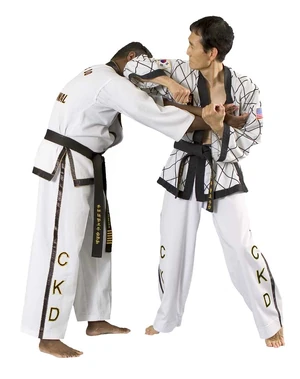
- Meaning: "The Way of Kwang Choi" (person)
- Type: kicking/striking
- Focus: self-defense
- Date of origin: 1987
- Founder: CHOI, Kwang-jo
- Popularity: niche
- Additional references: http://en.wikipedia.org/wiki/Choi_Kwang-Do
Choi Kwang Do was founded by Kwang Jo Choi in March 1987. Kwang Jo Choi was born in South Korea before emigrating to United States in the early 1970s. Choi was a successful ITF-style taekwondo practitioner and trainer (serving as a chief instructor) before establishing his own style.
Choi Kwang Do emphasizes the use of biomechanics, kinesiology, and psychology in its design. The result is a tendency towards the use of natural bilateral movement and fluid sequential motion to develop optimum force on impact to place less pressure on the joints. The style also incorporates breathing and stretching exercises from yoga.
Chung Sim Do
Chung Sim Do - Korean knife fighting? References needed.
Chun Kuk Do
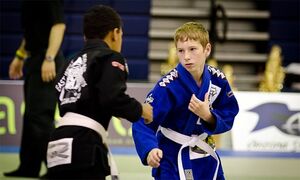
- Meaning: "The Universal Way"
- Type: American hybrid of Tang Soo Do
- Focus: self-defense
- Date of origin: 1990
- Founder: Chuck Norris
- Popularity: mainstream (but relatively small)
- Additional references: Chun Kuk Do and http://en.wikipedia.org/wiki/Chun_Kuk_Do
Chun Kuk Do is an American hybrid martial arts style based on Traditional Taekwondo styles such as Tang Soo Do / Moo Duk Kwan Taekwondo. Chun Kuk Do was established in 1990 by celebrity martial artist Chuck Norris. The governing body for Chun Kuk Do is the United Fighting Arts Federation (UFAF).
Chun Kuhn Do
- Type: Korean hybrid of taekwondo
- Focus: self-defense
- Founder: Bok Man Kim
- Popularity: niche
- Additional references: http://chunkuhndo.com/about.html
Chun Kuhn Do is a hybrid martial art developed by taekwondo pioneer Bok Man Kim. It combines many of the techniques from taekwondo with additional grappling techniques, weapons techniques, and defense-against-weapons techniques. Weapons taught include the sword and double-sword, cane, baton and double-baton, bayonet, knife and double knives, kamas, combat fan, pole, nun-chucks, and spear.
Gong Kwon Yusul
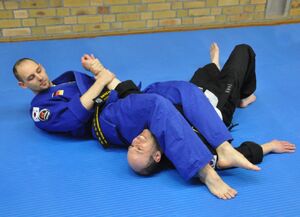
- Meaning:
- Type: hybrid
- Focus: self-defense
- Date of origin: 1996
- Founder: Kang Jun
- Popularity: niche
- Additional references: http://en.wikipedia.org/wiki/GongKwon_Yusul
Gongkwon Yusul is a modern Korean martial art system founded by Kang Jun in 1996. Its main influences include the martial arts of Hapkido, Hakko-ryu Jujutsu, Judo and Kyuk Too Ki. Gongkwon Yusul is a system which emphasizes the application of striking, locking, and throwing techniques in practical, free-flowing fighting situations, rather than the static applications, more in common in traditional styles of Hapkido. It also varies from Hapkido in that many of its hand techniques are strongly influenced by Western boxing, and that a significant part of Gongkwon Yusul training is in groundwork, applying techniques more akin to judo and Brazilian jiu-jitsu, than most Hapkido styles.
Gungsul (Korean Archery)
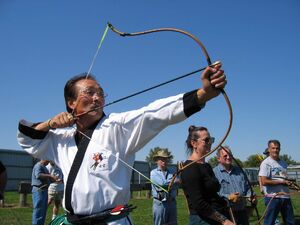
- Meaning: Korean Archery
- Type: bow
- Focus: ancient combat (now sport)
- Date of origin: ancient
- Popularity: mainstream / traditional practice
- Additional refererences: http://en.wikipedia.org/wiki/Gungdo
The Korean Bow (or Gungo; Korean: 각궁, Gak-gung) is a water buffalo horn-based composite reflex bow, standardized about 1900 C.E. from a variety of such weapons in earlier use. Gungsul, also written goongsul, literally means "the Craft of the bow."
Gwonbeop
- Meaning
- Type:
- Focus: combat
- Date of origin: ancient
- Popularity: ancient (not practiced)
- Additional references: http://en.wikipedia.org/wiki/Gwonbeop
Generally, the term Gwon Beop (Kwon Bop, Gwonbeop) is the term for unarmed methods in Korean martial arts as developed in the Joseon era (15th to 19th centuries). It is the Korean rendition of the Chinese Quan fa (拳法). In modern usage, the term Gwon Beop (like the term Kong Soo Do) may also apply to the Korean version of karate.
Destruction of the Korean palace and its libraries in 1126 C.E. has eliminated any literary history of Korea prior to that time. As a result no first-hand accounts of the origins of Gwon Beop. However, in 1145, King Injong (r. 1112-1146) ordered a Confucian Scholar, KIM Bu-sik, to compile Sam Kuk Sagi (lit. "History of the Three Kingdoms"). Some 100 years later a Buddhist monk, Iryeon, compiled the Sam Kuk Yusa (lit.: "Memorabilia of the Three Kingdoms"). Both works indicate that militant attitudes between and among the three major States of the Three Kingdoms Period (37 BCE - 660 AD) resulted in each nation developing an institution for training its warriors in Military Science. While the term Gwon Beop was not used, cadets of the Pyong Dang ("educational institute") in the Goguryeo kingdom learned punching, strikes and kicks (K. Ji Leu Ki Beop), while cadets of the Silla Kingdom learned Chil Kuk (kicks) and Soo Bak (punches and strikes). In the Kingdom of Baekje, "empty-hand fighting" (K. Soo Sool) was included in the training. Consolidation of the Korean peninsula under Silla in 668 enhanced the Silla approach to hand-to-hand combat over its neighbors, though continued and repeated conflicts provided opportunity to refine and enhance the material. Infrequent references to Soo Bak contests indicates that contests in unarmed combat, often with considerable wagering by the audience, occurred on holidays and other special occasions up until the invasion and dominance of Korea by Mongols (1231 - 1392).
Gwon Gyokdo (Korean Kickboxing)
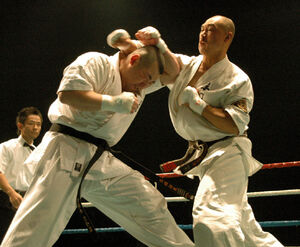
- Meaning: "The Way of the Fist Attack"
- Type: kicking/striking
- Focus: sport
- Date of origin: 1970s
- Founder: Jung Do Mo
- Popularity: mainstream
- Additional references: http://www.fullcontactmartialarts.org/kun-gek-do-korean-kickboxing.html and http://www.mardb.com/gwon-gyokdo
Gwon Gyokdo (also called Kun Gek Do, Kyuk Too Ki, or Korean Kickboxing) is a hybrid martial art that combines techniques from Muay Thai and Taekwondo. The idea is to combine basic Taekwondo kicking with the leg blocks, knee strikes, and elbow strikes that make Muay Thai so powerful. Gwon Gyokdo is a competitive sport in which competitors fight in a ring. Strength-training and body-hardening are emphasized.
Gyongdang
- Type: weapons-based
- Focus: combat
- Date of origin: ancient
- Popularity: ancient (not practiced)
The term Gyongdang refers to the "twenty-four methods" of Korean martial arts (primarily weapons-based: spear, sword, flail, etc.) that appear in the Muye Dobo Tongji.
Haedong Gum Do
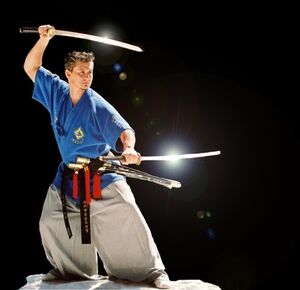
- Meaning: "The Way of Haedong Swordsmanship"
- Type: sword
- Focus: sport
- Date of origin: 1982
- Popularity: mainstream
- Founder: KIM, Jeong-ho
- Additional references: http://en.wikipedia.org/wiki/Haidong_Gumdo
Haedong Gum Do (also spelled Haidong Gumdo, Haedong Gumdo, 海東劍道 ; not to be confused with Han Kum Do) arose in April of 1983 as the Hai Dong Gumdo Association with its main office in Seocho-gu, Seoul and, in November, 1996 was incorporated as the World Hai Dong Gumdo Federation (WHDGF). The word Kumdo (also spelled Gumdo) is a general term for Korean swordsmanship.
In promoting his art, KIM Jeong-ho reported that in 1962 he began training with his master, a monk called Jang Paek-san, and opened the first "Way of the Eastern Sea" ("Hai Dong Kumdo") training hall in Anyang, Kyungki province, in July of 1982. To the degree that Hae Dong Kumdo draws on material gleaned from Bon Kuk Geom Beop, it could qualify as a type of historical martial arts reconstruction. While the purist may take exception to the selection of sword architecture to execute a given method, the theatrical or gymnastic qualities of practice and the inconsistent representation of provenance for this practice, its growing popularity has made it a staple of the Korean Martial Art community. Since 1996, branches of the WHDGDA have opened in a variety of countries including the United States, Canada, China, France, Germany, Spain, Australia, Mexico and Japan. Currently there are more than 300 dojangs and 2000 schools and companies teaching Hai Dong Gumdo in Korea. 500 dojangs have spread internationally.
Hankido
- Meaning: "The Way of Korean Energy"
- Type: hybrid
- Focus: sport
- Date of origin: 1980s
- Founder: NAM, Mung-jae
- Popularity: niche
- Additional references: http://en.wikipedia.org/wiki/Hankido and http://www.mardb.com/hankido
Hankido is a hybrid martial art that incorporates aspects of aikido with kicking, striking, and acrobatic flips. It is sometimes described as a style of hapkido. When training, spinning and dancing are used to develop coordination, rhythm, and timing.
Han Kum Do (Korean Swordsmanship)
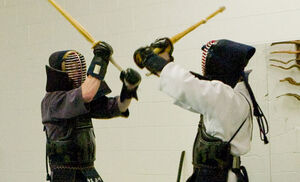
- Meaning: "The Way of Korean Swordsmanship"
- Type: sword
- Focus: sport
- Date of origin: 1986
- Founder: NAM, Myung-jae
- Popularity: mainstream
- Additional references: http://www.mardb.com/hankumdo
Han Kum Do is a sword-based martial art in which the basic cutting movements mimic the shapes of the Korean script known as Hangul. The word Kumdo (also spelled Gumdo) is a general term for Korean swordsmanship. The idea of basing the movements on the alphabet is to aid in the memorization of movements, thereby building muscle-memory for fast, complicated cuts that strike multiple targets quickly.
Han Moo Do

- Meaning: "The Way of Korean Martial Art"
- Type: hybrid
- Focus: sport
- Date of origin: 1989
- Founder: Young Suk (Finland)
- Popularity: niche
- Additional references: http://fi.wikipedia.org/wiki/Han_Moo_Do
Han Moo Do (not to be confused with Han Mu Do) is a Korean-based martial art founded in Finland. Han Moo Do incorporates elements of taekwondo, hapkido, and hoi jeon moo sool.
Han Mu Do
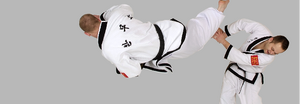
- Meaning: "The Way of Korean Martial Art"
- Type: hybrid
- Focus: self-defense
- Date of origin: 1990
- Founder: KIMM, He-young
- Popularity: niche
- Additional references: http://www.hanmudo-hapkido.com and http://nl.wikipedia.org/wiki/Hanmudo
Han Mu Do is a hybrid martial arts that combines elements of taekwondo and hapkido. The art is centered around the idea of combinations that quickly finish the opponent by first striking, then unbalancing, then throw the opponent. Han Mu Do also includes weapons training with swords, long and short staffs, and knives.
Hapkido
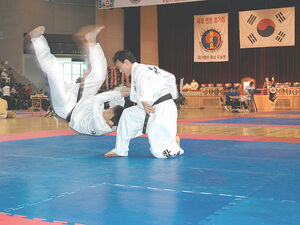
- Meaning: "The Way of Coordinated Power"
- Type: grappling/throwing
- Focus: self-defense
- Date of origin: 1950s
- Founder: CHOI, Yong-sool
- Popularity: mainstream
- Additional references: http://en.wikipedia.org/wiki/Hapkido
Hapkido (also spelled hap ki do or hapki-do; Hangul: 합기도; Hanja: 合氣道) is a dynamic and highly eclectic Korean martial art, related to Japanese Aikido. It is a form of self-defense that employs joint locks, grappling and throwing techniques of other martial arts, as well as kicks, punches, and other striking attacks. There is also the use of traditional weapons, including knife, sword, rope, jool bong (nunchaku), cane, short stick (dan bong), and middle-length staff (joong bong, gun, bō (Japanese)) which vary in emphasis depending on the particular tradition examined.
Hapkido contains both long- and close-range fighting techniques, utilizing jumping kicks and percussive hand strikes at longer ranges and pressure point strikes, joint locks, or throws at closer fighting distances. Hapkido emphasizes circular motion, redirection of force, and control of the opponent. Practitioners seek to gain advantage through footwork and body positioning to incorporate the use of leverage, avoiding the use of strength against strength.
The art adapted from Daitō-ryū Aiki-jūjutsu (大東流合気柔術) as it was taught by Choi Yong-Sool (Hangul: 최용술) when he returned to Korea after World War II, having lived in Japan for 30 years. This system was later combined with kicking and striking techniques of indigenous and contemporary arts such as taekkyeon, as well as throwing techniques and ground fighting from Japanese judo.
Early versions of Hapkido also went by the names Yu Kwon Sool, Yu Sool, Ho Shin Sool, and Bi Sool.
Hapki Yusul
- Meaning:
- Type: grappling / throwing
- Focus: self-defense
- Date of origin: 1987
- Founder: Kim Yun Sang
- Popularity: niche
- Additional references: http://en.wikipedia.org/wiki/Hapki_yusul
Hapkiyusul (Hangul: 합기유술) is a Korean martial art related to Hapkido. Kim Yun Sang (Hangul: 김윤상) began using the term "Hapkiyusul" in 1987, a year after Choi Yong Sul (the founder of Hapkido) died, in order to differentiate his style from mainstream hapkido.
Hoi Jeon Moo Sool
- Meaning: "The Revolving Martial Art"
- Type: primarily grappling, with some striking/kicking and weapons
- Focus: self-defense
- Date of origin: 1960s
- Founder: MYUNG, Jae-ok
- Popularity: niche
- Additional references: http://www.mardb.com/hoi-jeon-moo-sool and http://www.hoijeonmoosool.us
Hoi Jeon Moo Sool uses circular movements to generate power. The premise is that the use of the circular motion allows smaller individuals to move larger attackers with relative ease. Weapons training includes the use of swords, staves, fans, and canes.
Ho Shin Moo Sool
Hoshin Moosool is a hybrid martial art developed by Kwan Young Lee, the father of French taekwondo. Hoshin Moosool combines taekwondo, hapkido, and weapons training. References: http://www.hoshinmoosool.com
Ho Shin Sool
Ho Shin Sool is an early name for Hapkido. References: http://www.worldblackbelt.com/Martial_Arts_Styles/Hapkido.asp
Hup Kwon Do
- Meaning:
- Type: striking/kicking
- Focus: self-defense
- Date of origin: 1970s
- Founder: SING, Lim-ching
- Popularity: niche
- Additional references: http://www.mardb.com/hup-kwon-do
Hup Kwon Do, founded by Lim Ching Sing, was developed from Taekwondo. He left his original teacher Choi Hong Hi and became affiliated with Choi Kwang Do whose style was more fluid than Taekwondo. Hupkwondo is a synthesis of what he learned from these schools. More fluid movements replace traditional stances and full extension kicks and punches with smoother, more natural follow-through techniques.
Hwa Soo Do
Hwa Soo Do was an early name (1940s-1950s) for Tang Soo Do, the martial art practiced at Moo Duk Kwan.
Hwa Rang Do
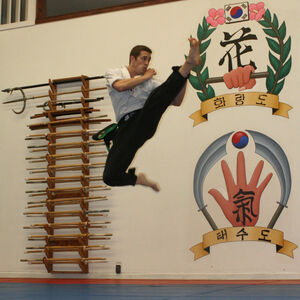
- Meaning: "The Way of Flowering Manhood"
- Type: weapon-based combat as well as unarmed combat
- Focus: ancient style of self-defense
- Date of origin: presumed to be based on an ancient style, revived in the 1950s
- Founders: LEE, Joo-bang and LEE, Joo-sang
- Popularity: niche
- Additional references: http://en.wikipedia.org/wiki/Hwa_Rang_Do
The Hwarang (화랑 "Flower Boys") were an elite group of young scholar-warriors in the ancient Korean kingdom of Silla. The Hwarang are credited with having spread martial arts throughout the Korean peninsula. The modern martial art Hwa Rang Do presumes to be based on the martial arts practiced by the Hwarang.
In 1942, according to Joo Bang Lee, a monk named Suahm Dosa took him and his brother, Joo Sang Lee, into his home for training. (Note that "Dosa" is actually his title, and it is roughly equivalent to "hermit sage expert.") They lived with Suahm Dosa at the Suk Wang Sa Temple in the Ham Nam province of North Korea, before later escaping with him to Ohdae Mountain in South Korea during the communist take over. (Suahm Dosa had no formal syllabus to teach them.)
After their training by Suahm Dosa. The brothers generated their syllabus from scratch, based on the techniques that they learned from Suahm Dosa, and then started to teach it to the public. Prior to their immigration to the United States, the Lee brothers were registered as Hapkido instructors in Seoul. In 1972, Joo Bang Lee moved to California, taking the World Headquarters of Hwa Rang Do with him. Joo Bang Lee currently holds the title of "Do Jo Nim" within Hwa Rang Do and he claims that he is the 58th successive holder of this title
During the course of training, a practitioner will learn long forms, short forms, basic techniques, kicking test, and various self defense techniques including one step sparring methods, defense against grabs and holds, defense against kicks, joint locks, throws, and various other techniques. In addition, various weapons will be taught including Ssang Jyel Bong (nunchaku), Jang Bong (long staff), and the Jang Kum (sword), and the Dan Bong (short stick). Defense against other weapons, such as the knife, are taught, but training with those weapons does not occur until black sash. Hwa Rang Do students will also have extensive study in ground fighting and grappling (Gotoogi), weapons sparring with bamboo swords (Gumtoogi) as well as staff and double stick fighting (Bongtoogi). According to the Aug/Sept 2014 issue of Black Belt Magazine, They launched their new full round open-hand fighting program called Yongtoogi. This program not only includes hand fighting and kick boxing, but it also includes takedowns, throws, and quick submissions. It is continuous five minute rounds, and the goal is to takedown and submit in five seconds.
Iin Tae Kwon
- Meaning:
- Type: taekwondo hybrid
- Focus: self-defense
- Date of origin: 2000
- Founder: Joon Jae Lee
- Popularity: niche
- Additional references: http://www.jjlee-itk.com/iintaekwon.asp
Iin-Tae Kwon is a modern taekwondo hybrid developed by taekwondo pioneer Joon Jae Lee. Iin-Tae Kwon combines Traditional Taekwondo with additional techniques including weapon disarms, joint-locks, and take-downs.
Kajukenbo
- Meaning: Karate + Judo + Kenpo + Boxing
- Type: hybrid
- Focus: self-defense
- Additional references: https://en.wikipedia.org/wiki/Kajukenbo
Kajukenbo is an American hybrid martial art. The name Kajukenbo is a portmanteau of the various arts from which its style is derived: KA for Karate and Tang Soo Do Korean Karate, JU for Judo and Jujutsu, KEN for Kenpo and BO for Western and Chinese Boxing. It was developed in the late 1940s and founded in 1947 in the Palama Settlement of Oahu, Hawaii. The art was created through the cooperative efforts of five martial artists, each with a different specialty: Peter Choo, Frank Ordonez, Joe Holck, Clarence Chang and Adriano Emperado. Kajukenbo training incorporates a blend of striking, kicking, throwing, takedowns, joint locks and weapon disarmament. Today, Kajukenbo is practiced all over the world in many different branches. In contrast to many traditional martial arts, students are not required to mimic their teacher, but are encouraged to develop their own "expression" of the art.
Keupso Chirigi
Keupso Chirigi is the Korean name for Japanese Kyushu Jutsu, the art of striking deadly points on the body.
Kong Soo Do
Kong Soo Do is a style of Traditional Taekwondo originally used by Jidokwan and Chang Moo Kwan. Essentially, it is a Korean adaptation of Okinawan karate. The term Gwon Beop (see above) is sometimes also used to refer to Korean karate.
Korean Kickboxing
See: Gwon Gyokdo.
Kuk Sool Do
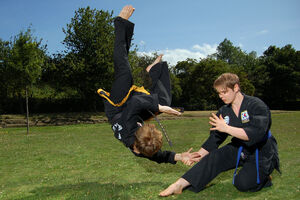
- Meaning:
- Type:
- Focus:
- Date of origin:
- Founder: YANG, Choon S.
- Popularity: niche
- Additional references: http://en.wikipedia.org/wiki/Kuk_Sul_Do
Kuk Sool (also spelled Kuk Sul) is a Korean martial arts style that was brought to the United States by Choon S. Yang. The name "Kuk Sul Do" translates to "National Korean Martial Art", and was put together from a number of different Korean martial art styles (but primarily taekwondo and kung fu) in order to preserve traditions and movements that are thousands of years old.
Kuk Sool Won
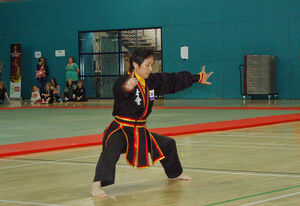
- Meaning: National Martial Art Association
- Type: hybrid
- Focus: sport
- Date of origin: 1958
- Founder: SUH, In-hyuk
- Popularity: niche
- Additional references: http://en.wikipedia.org/wiki/Kuk_Sool_Won
Kuk Sool Won (Hangul: 국술원) is a Korean martial arts system founded by Suh In-Hyuk (Hangul: 서인혁). The name Kuk Sool Won translates to "National Martial Art Association" and despite often being shortened to 'Kuk Sool,' the name kuk sool (국술; 國術) is a non-trade marked name used to denote similar Korean martial arts developed prior to or about the same time as the formation of Kuk Sool Won. Kuk Sool Won is currently taught world-wide and since it was founded as a martial arts system and not merely as a martial arts style, Kuk Sool Won does not consider itself limited to any single discipline. It attempts to be a comprehensive study of all traditional Korean martial arts. Suh In Hyuk's philosophy regarding his system is to "Integrate and explore the entire spectrum of established traditional Korean martial arts, body conditioning techniques, mental development, and weapons training."
Kumdo
See: Han Kum Do.
Kun Gek Do
See: Gwon Gyokdo.
Kun Mudo
- Meaning: "The Art of Punching"
- Type: martial dance
- Focus: Meditation
- Date of origin: 1957
- Founder: HA, Jong-hyo
- Popularity: niche
- Additional references: http://en.wikipedia.org/wiki/Kunmudo
Kunmudo (군무도), alternatively spelled 'Gunmudo', is based on dance and music. The music utilizes the gayageum, a Korean zither-like string instrument. In 1957, Jung-Hyo Ha founded a kunmudo-school, and started reforming the art along with his students.
Kunmudo is said to be a dance performed by ancient soldiers, and has its roots in the Silla kingdom (4th century). The Hwarang of this era were said to practice a martial art called 'Musa Chum', meaning 'sword dance' and might have been a predecessor of the modern form of Kunmudo.
The martial art itself contains both armed and unarmed techniques, and some of the weapons used includes Korean sword, spear and bow and arrow equivalents. The weapons training also include horseback riding. All techniques seem to switch between flowing elements reminiscent of T'ai chi, and explosive elements bearing some resemblance to Shaolin Kung Fu.
The current grandmaster of the system is Eung-Sun Kang, who travels around the world as an artistic dancer and martial arts instructor. There has also been some reports that seems to imply that Eung-Sun Kang has recently compiled his knowledge into a system called Poong Ryu Son Do, which includes kunmudo in its curriculum, but also includes other arts such as Vajra Zen Yoga.
Kung Jung Mu Sul
- Meaning: "Traditional Royal Court Martial Art"
- Type: combined
- Focus: combat
- Date of origin: ancient
- Founder: (modern style) YANG, Soon-tae
- Popularity: niche
- Additional references: http://www.kungjungmusul.com/history.html
The term Kung Jung Mu Sul (also spelled Koong Joong Mu Sool) refers to ancient Korean martial arts as practiced in the ancient royal courts of Korea. Typically these arts were weapons-based, incorporating fans, canes, short swords, and other small hand weapons.
Kung Jung Mu Sul has been revived in a modern style; the modern head of Kung Jung Mu Sul is Soon-tae Yang, formerly a master of Kuk Sool (see Kuk Sool, above; modern Kung Jung Mu Sul can probably be viewed as a variation of Kuk Sool).
Kwon Bop
See alternate spelling: Gwonbeop
For the term Kwon Bop Bu see Chang Moo Kwan.
Kyuki Do
- Meaning: "The Way of Explosive Energy"
- Type: hybrid
- Focus: self-defense
- Date of origin: American Kyuki-Do Federation was founded in 1979
- Founder: KIM, Ok-hyung
- Popularity: Practiced primarily in the U.S. with less than a dozen schools in Wisconsin, Illinois, Georgia, and Texas
- Additional references: http://www.mardb.com/kyuki-do , http://www.kyukidomartialarts.com
Kyuki Do is a Korean art that is a mix of taekwondo, judo, jiujutsu, hapkido, and kobudo. Kyuki-Do was introduced to the United States in 1967 by Ok Hyung Kim, the founder of the art. The American Kyuki-Do Federation was established in 1979. Kyuki-Do is an Art that combines the strikes of TaeKwon-Do, the throwing and grappling techniques of Judo and Juijitsu, the joint locks of HapKi-Do, and the practice of kobudo (traditional weapons) into one art.
A perfect balance of traditional Korean Martial Arts combined with the components of Judo, Jiu-Jitsu, Taekwondo and Hapkido. Furthermore, training in Kubudo weapons such as Bo, Sai, Nunchaku and the Filipino MA 'Kali' - the Art of Kyukido is one of the most comprehensive modern hybrid Martial Arts available across the United States.
Ma Sool
The term Ma Sool refers to Korean horsemanship; in a martial arts context the term pertains to combat from horseback, as with cavalry armed with bows.
Kyuk Too Ki
See: Gwon Gyokdo.
Sado Mu Sool
The phrase Sado Mu Sool (also spelled Sah Doh Mu Sool) is a generic term meaning "tribal or clan martial arts." The term generally refers to ancient Korean martial arts that would be passed down from generation to generation within family clans. It is believed that ancient martial arts such as Taekkyon likely started out as clan-based martial arts.
Shim Soo Do
- Type: sword-based
- Founder: James Benko
- Popularity: niche
- Additional references: http://www.itatkd.com/swordinfo.html
Shim Soo Do is an American-variant of Korean swordsmanship developed by James Benko.
Sib Pal Gi
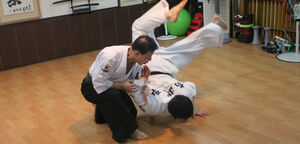
- Meaning: "The Eighteen Techniques"
- Type: striking
- Focus: combat
- Date of origin: ancient
- Founder: Kwang Suk Kim (modern version)
- Popularity: niche
- Additional references: http://en.wikipedia.org/wiki/Sib_Pal_Gi and http://www.mardb.com/shippalgi
Sib Pal Gi (also spelled Shippalgi) is the name sometimes used to describe the type of unarmed combat illustrated in the Muye Dobo Tongji. The word gwonbeop (see above) is also used, though gwonbeop is believed to have been a more generic term for unarmed combat in general.
The modern version of Sib Pal Gi is said to have been revitalized by KIM, Kwang-suk (김광ì„, 1936) who (during the Japanese occupation of Korea) spent his youth in a small Daoist community in the Korean mountains where he received his training in traditional Korean martial arts. The modern Sib Pal Gi Association (십팔기협회 Dae Han Sibpalki Hyeop Hwe; also The Korea Sibpalki Association) is a Korean martial arts association established in 1981 under the leadership of Kim.
Ssireum (Korean wrestling)
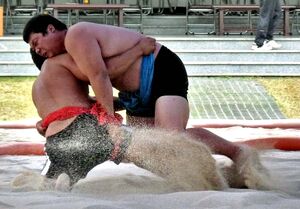
- Type: wrestling
- Focus: sport
- Date of origin: ancient
- Popularity: mainstream / traditional practice
- Additional references: http://en.wikipedia.org/wiki/Ssireum
Ssireum (Hangul: 씨름) or Korean wrestling is a folk wrestling style and traditional national sport of Korea. In the modern form each contestant wears a belt (satba) that wraps around the waist and the thigh. The competition employs a series of techniques, which inflict little harm or injury to the opponent: opponents lock on to each other's belt, and one achieves victory by bringing any part of the opponent's body above the knee to the ground.
Soobak
- Type: kicking/striking
- Focus: combat
- Date of origin: ancient
- Additional references: http://en.wikipedia.org/wiki/Subak
The term Subak (also spelled Soobak, or Soo Bahk) can have several meanings:
- Some authors use the term subak as a synonym for taekyon, considering the two to be identical.
- Author authors refer to to taekyon as being just one style of subak.
- Still others refer to subak as a Silla-specific derivative of taekyon.
The Mongul invasion of Korea in 1231 C.E. destroyed most written records up until that time (including any written records that might have pertained to martial arts), so it is very possible that historians will never be able to reconcile these ambiguities.
Soo Bahk Do
- Meaning:
- Type: kicking / striking
- Focus: self-defense
- Date of origin:
- Founder: Hwang Kee
- Popularity: mainstream
- Additional references:
Soo Bahk Do is the name of a martial art founded by Hwang Kee of the Moo Duk Kwan based on the ancient martial art Subak. The martial art originally founded by Kee was Tang Soo Do. After he read the Muye Dobo Tongji he renamed the art Soo Bahk Do, having incorporated what he interpreted from the Muye Dobo Tongji. Soo Bahk Do, then, can be viewed as an offshoot of Tang Soo Do.
Sulsa
Sulsa is a historical term refering to an elite corps within the Hwarang.
Sun Kwan Moo aka Sun Mudo
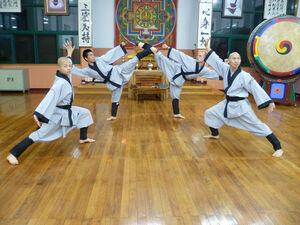
- Meaning: "Zen contemplation of enemies"
- Focus: meditation
- Date of origin: 1945
- Founder: Yang-ik
- Popularity: niche
- Additional references: http://en.wikipedia.org/wiki/Sunmudo and http://www.mardb.com/seon-kwan-moo
Sun Kwan Moo (also spelled Seon Kwan Moo, also called Sun Mudo; not to be confused with Sun Moo Kwan, a school of Hapkido; also not to be confused with Song Moo Kwan, one of the original Nine Kwans of taekwondo) is a little-known and fairly recent Buddhist-based Korean martial art that focuses on the meditative aspects of martial arts. The formal name of Sunmudo is Bulgyo Geumgang Yeong Gwan (Hangul: 불교금강영관 Hanja: 佛敎金剛靈觀). The name Sunmudo was given to this martial art in 1984 by the Buddhist monk Jeog Un (적운 스님).
In ancient times Korean Buddhist monks were encouraged to practice Zen martial arts as a way of dynamic meditation. In the 1500s Korean monks used swords, knives, spears and throwing stars to help repel a Japanese invasion. However, the temple of the Korean monks was burned by retreating troops in revenge. In the 1930s and 1940s, a rebuilt Beomeosa temple became center for the monks' underground resistance to Japanese occupation. However, the martial art of Sunmudo had been neglected since the 19th century. At Beomeosa temple located in Busan, Monk Yang-ik revived the art by systematizing the techniques. Monk Jeogun worked on its popularization during the 1970s. These days training is offered to non-Buddhists and laypersons at Golgulsa temple in Korea, and other places around the world as well.
Taekwondo
See main article: Taekwondo.
Taekyon
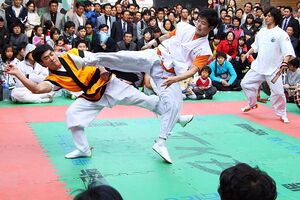
- Type: emphasis is on foot techniques, such as kicks and sweeps
- Focus: believed to have historically been primarily a sport
- Date of origin: ancient
- Popularity: niche (traditional practice)
- Additional references: Taekyon and http://en.wikipedia.org/wiki/Taekkyeon
The term Taekkyon (also spelled taekkyoen, or taekyon) is used to refer to what is believed to have been an ancient Korean martial art. Historical records regarding taekkyon, however, are scant. The first explicit written reference to taekkyon appears during the Joseon Dynasty. It is believed that there may have been multiple styles of taekkyon, with subak being an example of one style, but this is conjecture. Other authors believe that taekkyon may have been nothing more than a folk dance. Note that it is possible for both views to be correct: for example, over centuries a martial art could evolve to become a folk art, and in fact even in taekwondo today there is a tendency in Korea to combine martial arts with dance.
The name of the modern Korean martial art taekwondo was chosen in-part because it harkens to the name taekyon.
Tae Soo Do
Tae Soo Do was one of the original names given to Traditional Taekwondo by members of the Nine Kwans. See Taekwondo History for more detail.
Nowadays the name "Tae Soo Do" is also used to refer to a style of Hwa Rang Do (see above).
Tang Soo Do
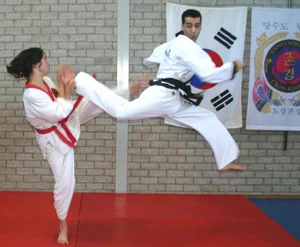
- Meaning: "The Way of the Chinese Hand"
- Type: kicking/striking
- Focus: self-defense
- Date of origin: 1950s
- Founder: Won Kuk Lee
- Popularity: mainstream
- Additional references: Tang Soo Do and http://en.wikipedia.org/wiki/Tang_Soo_Do
Tang Soo Do (Hangul: 당수도) is a Korean martial art incorporating fighting principles from subak (as described in the Kwon Bup Chong Do), as well as northern Chinese kung fu. The techniques of what is commonly known as Tang Soo Do combine elements of Shotokan Karate, Subak, Taekkyon, and Kung Fu. Tang Soo Do is essentially a form of "traditional" taekwondo.
Between 1910 and 1945, Korea fell under Japanese occupation. During this time, the practice of native Korean martial arts was banned. Korean martial arts, however, were still practiced secretly, influenced by Japanese karate practitioners willing to share their knowledge during that time. Eventually, when the Japanese domination was lifted, martial arts schools began to appear across Korea, the first of which was the Chung Do Kwan, whose founder was Won Kuk Lee. Lee is regarded as the first to use the term "Tang Soo Do" to describe what became the Korean fighting art that has been influenced by so many other styles. The term "Tang Soo Do" (or "Dang Soo Do") is the Korean pronunciation of the characters 唐手道, "The Way of the Chinese Hand," which was in widespread use in Okinawa and Japan in the early 1900s.
Tang Soo Do was further popularized by Hwang Kee of Moo Duk Kwan.
T'ang Su
- Meaning: "Tang Hand"
- Date of origin: ancient
- Popularity: extinct
- Additional references: http://www.mackido.com/MartialArts/Glossary_Arts.html, http://www.kidokwan.org/articles/the-evolution-of-taekwondo-from-japanese-karate
An ancient (extinct) Korean martial art which originally came from China.
Um-Yang Kwon
- Meaning: "Yin-Yang Fist"
- Date of origin: (presumably) ancient
- Popularity: (presumably) extinct
- Additional references:
Um-Yang Kwon (음앙권 陰陽拳) is claimed by some to be the name of the martial art practiced by the Hwarang. The term generally appears in write-ups by modern practitioners of Hwarang-do, who claim Um-Yang Kown as the ancient name for thir martial art.
Teukgong Moosool
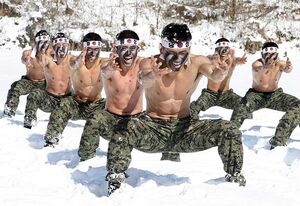
- Meaning:
- Type:
- Focus: combat
- Date of origin: 1960s
- Founders: South Korean Special Forces
- Popularity: military usage
- Additional references: http://en.wikipedia.org/wiki/Teukgong_Moosool
Teukgong Moosool (alsp spelled Tukong Moosul, or abbreviated as TGMS) is a martial art originating from South Korea. It is the official martial art practiced by the South Korean Special Forces. Teukgong Moosool is a combative method of fighting as opposed to a sport. It emphasis the rapid interdiction and submission of an opponent. TGMS has been adapted beyond the special forces, for practice by bodyguards, police and law enforcement personnel and individuals interested in an effective method of self-defense.
Teukgong Moosool arose following a protracted period of North Korean Special Forces penetration across the border during the 1960s and 1970s, demonstrating superior combat skills.In one particular foray, North Korean special forces personnel were apprehended. One of them, proficient in Gyeuk Sool, was able to dismiss three South Korean commandos within 10 seconds in hand to hand combat. This prompted the South Korean special forces to create a superior fighting system, in pursuit of an ultimate martial arts system. The South Korean military drew upon martial arts experts in all fields to develop an ultimate hand to hand combat style that could employ any weapon or no weapon. By 1979, this style — Teukgong Moosool – had been adopted in an official capacity by the South Korean Special Forces. The founders are considered Grand Masters Lim, No Won Park and Chang So Ok, although the founding is the result of the input of a number of Grand Masters from various traditions within Korean Martial Arts.
TGMS incorporates the most effective features of Hapkido, Taekwondo, Chinese martial arts, Judo and Kyuk Too Ki. Its sparring primarily revolves around Kyuk Too Ki. In addition, grappling techniques are heavily emphasized as are submissions and joint manipulations of Hapkido. Judo throws are also learned, as is the footwork of Taekwondo. Weapons are a central aspect of TGMS and include Nun Chakau, Knives, Swords, Staff, short Staff and firearm, although weapons defense is taught within the legal environment of the country, meaning in Europe there is no use of firearms.
Won Hwa Do
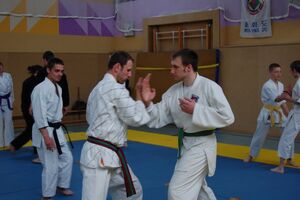
- Meaning: "The Way of Circular Harmony"
- Type: hybrid
- Focus: self-defence
- Date of origin: 1972
- Founder: HAN, Bong-ki
- Popularity: niche
- Additional references: http://www.mardb.com/wonhwado and https://www.facebook.com/wonhwado
Won Hwa Do (WHD) is a hybrid martial art that emphasizes rotation to generate power (not unlike the Tornado Kick in taekwondo). Weapons such as the short stick, knife, and sword are routinely used.
WHD principles are based on ancient Korean beliefs. The ancient traditional method of praying was by means of rubbing the palms of both hands together in a circular fashion, representing Yin and Yang (called Eum and Yang in Korea, see Taegeuk for additional detail). Through this circular motion, it was believed that one could create and transmit energy, thereby bringing healing to mind and body. It was also believed to be a way to achieve self-understanding, to communicate with nature, and to create harmonious and loving relationship with other people. The philosophy of WHD is based on the idea of circular energy. It is well understood that the flow of nature and the universe are often through circular motions and cycles. The circle is the configuration in nature that uses least energy and is natural, self-sustaining and eternal. The core principle of WHD techniques then are applied as rotations of 360 degrees. This circular motion starts from a small movement of rubbing hands and can become attack and defence techniques when being enlarged step by step to a bigger circular motion. "Within circular forms, all movements can be incorporated with the least expenditure of energy. WHD can be used for restoring and maintaining health of mind and body. This circular martial art is a way of establishing a stable, healthy, harmonious and creative life through practicing circular motions and building circular mind. Nature supports the movement of circular energy. Through WHD, one can become a more natural being" - WHD Master Kim Do Rim
Yongmudo
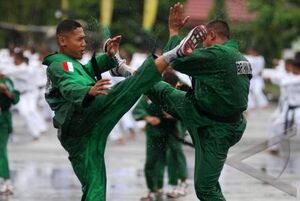
- Meaning: "The martial art of Yong"
- Type: modern, hybrid/mixed martial art
- Focus: self-defense
- Date of origin: 1999
- Founder: Yong-In University
- Popularity: niche
- Additional references:
Yongmudo (also spelled Yongmoodo) is a modern, hybrid martial art that was developed by sports scientists at Yong-In University in Korea. Yongmudo combines kicking techniques from taekwondo, grappling and throwing techniques from hapkido, throwing techniques from judo, and wrestling techniques from ssireum.
Yudo
Yudo is the Korean pronounceation of the word Judo.
Yu Kwon Sool
Yu Kwon Sool is an early name for Hapkido. References: http://www.worldblackbelt.com/Martial_Arts_Styles/Hapkido.asp
Yu Sool
In modern usage, Yu Sool is an early name for Hapkido. References: http://www.worldblackbelt.com/Martial_Arts_Styles/Hapkido.asp
The term Yu Sool is also the name for an ancient (extinct) Korean martial art, strongly Chinese influenced, that was a soft internal system. Reference: http://www.mackido.com/MartialArts/Glossary_Arts.html
References
- http://en.wikipedia.org/wiki/Korean_martial_arts
- http://taekwondopreschool.com/koreanmartialarts.html
- http://www.mardb.com/country/korea
- http://www.amazon.com/Way-Warrior-Martial-Fighting-Styles/dp/0756639751
- http://www.allmartialarts.com/KIXCO/History/history/map.htm
- http://www.mackido.com/MartialArts/Glossary_Arts.html
- http://www.maotw.com/list/ma01.html
| This page uses Creative Commons Licensed content from Wikipedia (view authors). |